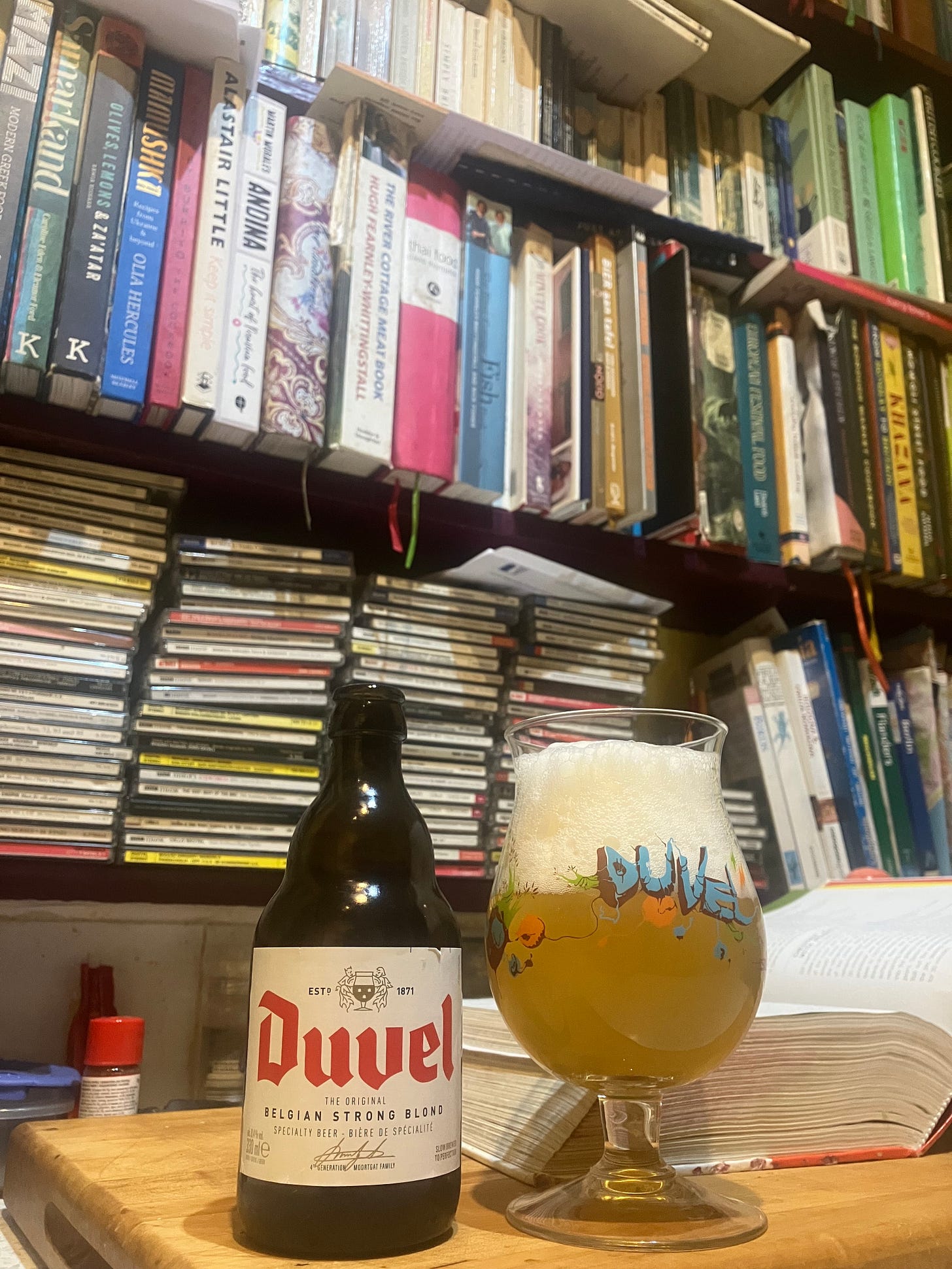‘Horror, horror, horror.’
The first words in a diary entry, Tuesday, October 20, 1987.
‘Had a disgusting hangover. Never again that poison Duvel.’
I was in Eindhoven along with a then girlfriend to see a mate who worked there. A couple of days earlier in a bar in Brussels he had introduced me to Duvel. I liked it and was also fascinated by the thistle-shaped glass it was poured into, but on the night previous to this ungainly, intoxicated, poisonous morning during which I wrote those bilious-stricken words I had drunk eight bottles of Duvel in a bar whose name I have long forgotten. Hence one of the worse beer hangovers ever.
I never kept my oath to stay away from Duvel and it is one of those beers I have come to love. In remembering my introduction to it nearly 40 years ago I am reminded of a time when the diversity and gloriousness of the beers of Belgium were new to me, revolutionary even. Here were beers that had more in common with wine, beers brewed by monks, beers that were Herculean in their strength. At the time, previous to being introduced to Duvel, I would have been aware of Stella and that would have been it, and certainly not lambic (that came in the mid 1990s on a visit to Cantillon). There was a whole new world unfolding itself ahead of me and now I occasionally feel like Alexander the Great when he cried upon believing that there were no new worlds for him to conquer. He had reached his zenith and stopped believing in anything that would sustain and nourish him.
Ten years later I was in Paters Vaatje in Antwerp, on my own, sitting on a stool at the bar, mulling with a glass of Duvel.
‘Alone. Europe. Natural habitat. Duvel. Music.’ Well at least that is what my notes said.
Going back to 1987, when I first drunk Duvel, I didn’t know what to make of it. There was its glass for instance, as well as shaped like a thistle I thought it also reminiscent of a chalice, very much out of the age of Arthur, the kind of glass that encouraged toasts, both to those who drunk it with you or to the very beer itself, such was its pristine character.
What did the beer taste like then? I can write on what it tastes like now, but then it was — if my memory serves me right — a taste of difference, not easy perhaps, but difference. This was a totally different beer to what I was used to drinking. This was a new flavour experience, on a par with my first dish in what we used to call a Chinese restaurant at the age of 12 with my father on Saturdays when we used to see him. Or the time in Bologna when an interview with a chef and the subsequent meal I was served made me realise how good a beef ragù could be.
My tasting notes on Duvel in 1994:
A classic beer fermented in the bottle. Pour slowly, colour golden yellow. Best served in a thistle shaped glass. Strong yeasty aroma. Bitter tasting, hoppy. Chocolate notes. Excellent with braised beef. Strong enough to complement the sweetness of a dish cooked in beer.
Chocolate! I would like to think I have come on since then. This is 2019.
‘The beer gleams in the glass with the beatific assurance of a monk passing a benediction; it sparkles, it glitters, it flitters like a bat in the gloaming; it smiles benignly beneath its Alpine snow white collar of foam offering the assurance to those who truly believe. To most of us, it is just a beer, part of a family of beers, some of which quench our thirsts, others that celebrate the end of the working day and are shared between friends, while the more monkish like the kind of beer to contemplate by the fireside.
‘On the other hand, let us taste the beer, change the mood, spoil the moment and bite into the foam and what do we taste? To begin with the zesty, moody, broody orange peel notes of the hops are apparent, a memory even of breakfast marmalade — sweet citrus child of mine — spread on lightly toasted white bread. The taste is full, a return of the marmalade and toast, a sweetness, perhaps a slight bitterness, and is that a finish as dry as an aside from a cultured friend?’
I have drunk this beer throughout Belgium, in the UK and the USA, in the Netherlands and in a bar in Malaga, where I overheard a Brit say, ‘very chocolaty’, but he didn’t have a Duvel. I have even been to the brewery where it is made and matched it with a very young cheese. It is not my favourite beer (I sometimes feel that picking your favourite beer is like a parent being asked to name a favourite child), but it has become a constant companion throughout a beer-drinking life, in spite of that horror many years ago when excess championed the sort of distress none of us really feel valiant in the company of.
Shameless plug: my latest book A Pub For All Seasons has had some great reviews in the press and is available from all good bookshops and online (Headline).





